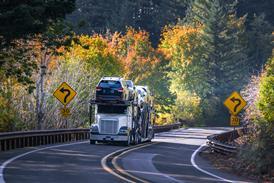 Europe’s automotive supply chain experts got an opportunity to see how the other side lives at this year’s Automotive Logistics Europe conference, with a presentation on the logistics at American coffee-chain giant Starbucks. Jan Huijgens (pictured), senior manager of logistics for the European region, revealed that logistics is a strong competitive advantage at Starbucks, and is measured strictly on perfect order fulfilment.
Europe’s automotive supply chain experts got an opportunity to see how the other side lives at this year’s Automotive Logistics Europe conference, with a presentation on the logistics at American coffee-chain giant Starbucks. Jan Huijgens (pictured), senior manager of logistics for the European region, revealed that logistics is a strong competitive advantage at Starbucks, and is measured strictly on perfect order fulfilment.
Huijgens showed that automotive is far from being the only industry dealing with complex, global supply chains and high part numbers. For the Europe, Middle East and Africa region, the company now has 2,000 stores (including more than 700 in the UK), which it serves with more than 1,200 stock keeping units. The material flow is made up not only of coffee beans, but also store supplies (including cups, mugs, napkins, etc), food, tea and merchandise.
The coffee beans are sourced from South America, Africa and Indonesia, while Starbucks imports a portion of its supplies for Europe from the US, and most of the merchandise from the Far East. The company has a plant near to Amsterdam where all of its coffee beans are roasted. All of the coffee therefore comes into Europe by sea freight to the Netherlands, and is then fed through Starbucks distribution network, which includes two main distribution centres and several crossdocks. Other supplies and merchandise can be imported directly to other ports and enter the network as appropriate.
Starbucks has a disciplined and fast-turning order management process. Most of the stores in the core markets order supplies everyday, which they then receive within a few days.
“We are measured on perfect order fulfilment,” said Huijgens. “Our product has a perishable demand and if we are not accurate in our forecasts and reliable in our delivery, we put our businesses at risk.”
Huijgens said that Starbucks’ supply chain has to be very resilient, as the company is subject to variations in weather than have a big impact on both its inbound and outbound supply chains. For example, growing seasons affect the timing of shipments of green coffee from around the world. Likewise, weather can have big impacts on consumer habits. “Last year we had eight weeks of unseasonally warm weather across most of Europe in August and September, which drove demand for our cold drinks and products,” he said. “We had to turn segments of our supply chain upside down to keep up with demand.”
Same but different
Huijgens did point to the complexity of moving goods that needed special storage or refrigeration, and the importance of velocity and flow in a supply chain with a product that must be kept fresh. But he also acknowledged that the food and beverage industry is still learning the ‘lean’ mindset that is so ingrained in the automotive industry.Earlier in the conference, a live voting survey revealed that 55% of participants thought that automotive logistics was still leading edge relevant to other industry, but mainly because of its historic innovations (such as lean, just-in-time, etc) and not for its developments today. Huijgens who joined Starbucks in 2009 following a career in automotive supply chain and logistics, including most recently a tier one supplier, was reluctant to label the company’s logistics as more innovative than that of automotive. Many of the processes and dynamics of the industry are similar, including the distribution and crossdock network. Likewise, the order fulfilment discipline bears some similarities to automotive spare parts distribution.
Huijgens told Automotive Logistics that the company is starting to see similar trends towards localisation that some carmakers are also experiencing in Europe. There are two factors at play, both of which are similar to automotive. Firstly, Starbucks started its business in EMEA with much the same approach that carmakers do when going into a new country: by supplying the market mainly from its home base in the US. As it has grown in Europe, Starbucks has increased the amount of merchandise, food and equipment that it sources in Europe.
Secondly, he said, “The company is reviewing some of its long lead time items and is looking for more responsive sources of supply. For items that were off-shored for cost reasons in the past 5 years, we are now looking if we can source them closer without losing the cost advantage.“























